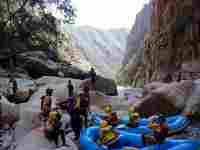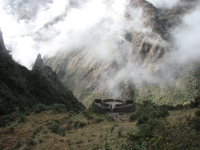
A number of powerful rivers race within Peru's borders, including the mighty Amazon. Experienced paddlers will find some challenging stretches of white-water, while novices can enjoy the country's gentler runs. The Urubamba Valley, the Colca and Cotahuasi Canyons, and the Rio Santa and Tambopata Rivers have terrific options. Adventurers can also tackle many wonderful stretches near Arequipa, which makes a great base for rafting and kayaking holidays.Adrenalin rush aside, river trips allow travellers to access landscapes that might otherwise be very difficult to explore. Many of the country's steep desert canyons and overgrown jungle valleys are best traversed by boat, with wildlife sometimes appearing along the banks.May through September are the best months for white-water rafting, when water levels are low. Rivers become dangerous during the rainy season (summer). Travellers should note that many of Peru's tour operators offer white-water trips.

A reliable swell, fairly warm water and consistent offshore winds make Peru a tremendous surfing destination. The north coast in particular has long, empty waves in beautiful locations, plus one of the world's largest left-hand point breaks.Local surfers generally head to Lima, which receives an almost daily bounty of good waves, and has popular surf spots. The region's barrels, beach breaks, point breaks, sandbars and rocky bottoms cater for all levels of experience.Regarding conditions, many surfers go without wetsuits during summer, but wear short-sleeved suits in spring and autumn. Full-body 3.2mm suits and booties are a good idea in winter. The water is warmer than on the Californian coast, but can get chilly. Sharks are not an issue.

The world-famous Inca Trail is the toast of South America's hikes. Constructed as a royal road to the citadel of Machu Picchu, the dramatic, stone-paved walk ventures deep into cloud forests, and climbs the mountains to the sky.The beautiful but arduous four-day trail is part of the Machu Picchu Historic Sanctuary, and a World Heritage Natural and Cultural Site. Hikers who begin it will cross over three high-altitude mountain passes, and see scattered Inca ruins on their way to the citadel. The region's forests, exotic vegetation and breath-taking mountain views are ever-present companions. Ultimately, the ancient royal route reaches the stone Sun Gate, from where Machu Picchu becomes visible. Huayna Picchu's looming peak dominates the background.Regarding access, travellers must arrange their hikes through an official Inca Trail tour agency, and go as part of an organised group. Independent trekking is prohibited. The number of hikers permitted on the trail at any time is limited, and all parties will require permits. Travellers should book permits long in advance to avoid disappointment.Otherwise, visitors should remember that the trail is steep, and that the high-altitude makes it especially challenging.

Travel Guide powered by Word Travels, copyright © 2023 Globe Media Ltd. By its very nature information in this travel guide is subject to change at short notice and travellers are urged to verify information on which they're relying with the relevant authorities. Neither Globe Media Ltd nor Travel Vogue can accept any responsibility for any loss or inconvenience to any person as a result of information contained above.